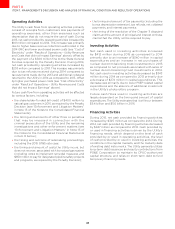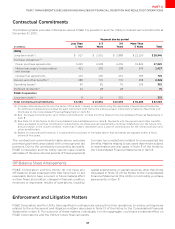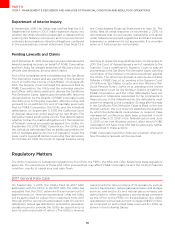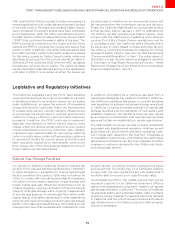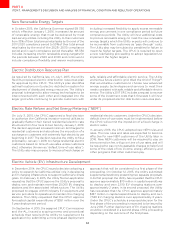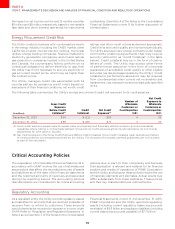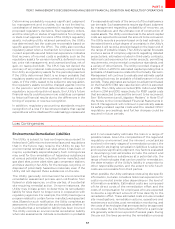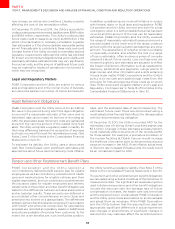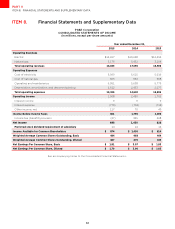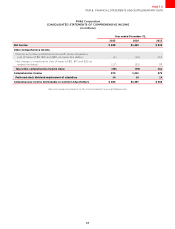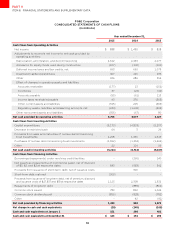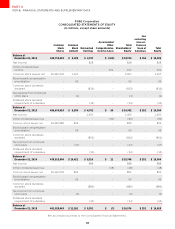PG&E 2015 Annual Report Download - page 66
Download and view the complete annual report
Please find page 66 of the 2015 PG&E annual report below. You can navigate through the pages in the report by either clicking on the pages listed below, or by using the keyword search tool below to find specific information within the annual report.
58
PART II
ITEM 7.MANAGEMENT’S DISCUSSION AND ANALYSIS OF FINANCIAL CONDITION AND RESULTS OF OPERATIONS
may change, as well as site conditions, thereby possibly
aecting the cost of the remediation eort.
At December 31, 2015 and 2014, the Utility’s accruals for
undiscounted gross environmental liabilities were $969 million
and $954 million, respectively. The Utility’s undiscounted
future costs could increase to as much as $1.9 billion if the
extent of contamination or necessary remediation is greater
than anticipated or if the other potentially responsible parties
are not financially able to contribute to these costs, and could
increase further if the Utility chooses to remediate beyond
regulatory requirements. Although the Utility has provided
for known environmental obligations that are probable and
reasonably estimable, estimated costs may vary significantly
from actual costs, and the amount of additional future costs
may be material to results of operations in the period in
which they are recognized.
Legal and Regulatory Matters
PG&E Corporation and the Utility are subject to various
laws and regulations and, in the normal course of business,
are named as parties in a number of claims and lawsuits.
In addition, penalties may be incurred for failure to comply
with federal, state, or local laws and regulations. PG&E
Corporation and the Utility record a provision for a loss
contingency when it is both probable that a loss has been
incurred and the amount of the loss can be reasonably
estimated. PG&E Corporation and the Utility evaluate
the range of reasonably estimated losses and record a
provision based on the lower end of the range, unless an
amount within the range is a better estimate than any other
amount. The assessment of whether a loss is probable
or reasonably possible, and whether the loss or a range
of loss is estimable, often involves a series of complex
judgments about future events. Loss contingencies are
reviewed quarterly and estimates are adjusted to reflect
the impact of all known information, such as negotiations,
discovery, settlements and payments, rulings, advice of
legal counsel, and other information and events pertaining
to a particular matter. PG&E Corporation’s and the Utility’s
policy is to exclude anticipated legal costs from the
provision for loss and expense these costs as incurred.
(See “Enforcement and Litigation Matters” and “Legal and
Regulatory Contingencies” in Note 13 of the Notes to the
Consolidated Financial Statements in Item 8.)
Asset Retirement Obligations
PG&E Corporation and the Utility account for an ARO at
fair value in the period during which the legal obligation
is incurred if a reasonable estimate of fair value and its
settlement date can be made. At the time of recording an
ARO, the associated asset retirement costs are capitalized
as part of the carrying amount of the related long-lived
asset. The Utility recognizes a regulatory asset or liability for
the timing dierences between the recognition of expenses
and costs recovered through the ratemaking process. (See
Notes 2 and 3 of the Notes to the Consolidated Financial
Statements in Item 8.)
To estimate its liability, the Utility uses a discounted
cash flow model based upon significant estimates and
assumptions about future decommissioning costs, inflation
rates, and the estimated date of decommissioning. The
estimated future cash flows are discounted using a
credit-adjusted risk-free rate that reflects the risk associated
with the decommissioning obligation.
At December 31, 2015, the Utility’s recorded ARO for the
estimated cost of retiring these long-lived assets was
$3.6 billion. Changes in these estimates and assumptions
could materially aect the amount of the recorded ARO
for these assets. For example, a premature shutdown of
the nuclear facilities at Diablo Canyon would increase
the likelihood of an earlier start to decommissioning and
cause an increase in the ARO. If the inflation adjustment
or discount rate increased 25 basis points, the result would
be an immaterial impact to ARO.
Pension and Other Postretirement Benefit Plans
PG&E Corporation and the Utility sponsor a
non-contributory defined benefit pension plan for eligible
employees as well as contributory postretirement health
care and medical plans for eligible retirees and their
eligible dependents, and non-contributory postretirement
life insurance plans for eligible employees and retirees.
Adjustments to the pension and other benefit obligation are
based on the dierences between actuarial assumptions
and actual plan results. These amounts are deferred in
accumulated other comprehensive income (loss) and
amortized into income on a gradual basis. The dierences
between pension benefit expense recognized in accordance
with GAAP and amounts recognized for ratemaking
purposes are recorded as regulatory assets or liabilities as
amounts are probable of recovery from customers. To the
extent the other benefits are in an overfunded position,
the Utility records a regulatory liability. (See Note 3 of the
Notes to the Consolidated Financial Statements in Item 8.)
The pension and other postretirement benefit obligations
are calculated using actuarial models as of the December31
measurement date. The significant actuarial assumptions
used in determining pension and other benefit obligations
include the discount rate, the average rate of future
compensation increases, the health care cost trend rate
and the expected return on plan assets. PG&E Corporation
and the Utility review these assumptions on an annual basis
and adjust them as necessary. While PG&E Corporation
and the Utility believe that the assumptions used are
appropriate, significant dierences in actual experience,
plan changes or amendments, or significant changes in
assumptions may materially aect the recorded pension


